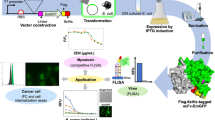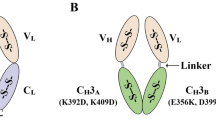Abstract
Single-chain variable fragment (scFv) has great prospect in medical therapies and diagnostic applications due to its binding affinity and low immunogenicity. However, the application of scFv is limited by its heterologous expression facing challenges of insoluble aggregation. sfGFP has been developed as fusion tag to facilitate the solubility of fusion partner in Escherichia coli. We designed fusion protein of anti-influenza PB2 scFv at C-terminus of sfGFP and successfully obtained soluble expression of sfGFP-scFv-His in Escherichia coli. The expression level of sfGFP-scFv-His reached at 20 mg/L of bacterial culture when the culture was induced with 0.1 mM IPTG at 18 °C for 16 h. And 6 mg scFv-His was obtained from the cleavage of 10 mg pure sfGFP-scFv-His with TEV protease. In addition, we found that sfGFP-scFv-His was more stable than scFv-His in chicken serum, suggesting that sfGFP not only facilitated the solubility of scFv in Escherichia coli, but also promoted the stability of scFv. The immunologic activity of sfGFP-scFv-His was confirmed by Western blot and ELISA; the results showed that anti-PB2 sfGFP-scFv-His exhibited specific binding to PB2. Hemagglutination and comparative real-time RT-PCR analysis indicated that sfGFP-scFv-His and scFv-His inhibited the replication of H1N1 influenza virus in the infected A549 cells. These results further develop the application of scFv as an agent, such as anti-influenza. Furthermore, soluble expression of scFv using sfGFP as fusion partner provide a cost-effective preparation model for manufacturing scFv against pandemic disease.








Similar content being viewed by others
References
Ahmad ZA, Yeap SK, Ali AM, Ho WY, Alitheen NB, Hamid M (2012) scFv antibody: principles and clinical application. Clin Dev Immunol 2012:980250
Barcena J, Ochoa M, delaLuna S, Melero JA, Nieto A, Ortin J, Portela A (1994) Monoclonal antibodies against influenza virus PB2 and NP polypeptides interfere with the initiation step of viral mRNA synthesis in vitro. J Virol 68:6900–6909
Beaton AR, Krug RM (1986) Transcription antitermination during influenza viral template RNA synthesis requires the nucleocapsid protein and the absence of a 5' capped end. Proc Natl Acad Sci USA 83:6282–6286
Biocca S, Cattaneo A (1995) Intracellular immunization: antibody targeting to subcellular compartments. Trends Cell Biol 5:248–252
Boulo S, Akarsu H, Ruigrok RW, Baudin F (2007) Nuclear traffic of Influenza virus proteins and ribonucleo protein complexes. Virus Res. 124:12–21
Chaisri U, Chaicumpa W (2018) Evolution of therapeutic antibodies, influenza virus biology, influenza, and influenza immunotherapy. Biomed Res Int 2018:9747549
Cros JF, Palese P (2003) Trafficking of viral genomic RNA into and out of the nucleus: influenza, Thogoto and Borna disease viruses. Virus Res. 95:3–12
Devyani S, Asma S, Sandeep B, Atul KP, Rekha K, Richa CS, Anil P, Bramhadev P, Hare KP (2014) Development of single-chain Fv against the nucleoprotein of type A influenza virus and its use in ELISA. J Virol Methods 208:129–137
Eiryo K, Tokiko W, Ken F, Hideo G, Shinji W, Takeshi N, Yoshihiro K (2011) Strand-specific real-time RT-PCR for distinguishing influenza vRNA, cRNA, and mRNA. J Virol Methods 173:1–6
Frenzel A, Hust M, Schirrmann T (2013) Expression of recombinant antibodies. Front Immunol 4:217
Gabriel G, Dauber B, Wolff T, Planz O, Klenk HD, Stech J (2005) The viral polymerase mediates adaptation of an avian influenza virus to a mammalian host. Proc Natl Acad Sci USA 102:18590–18595
Gao Y, Sun L, Dong J, Xu X, ShuY CM, Yin L, Liang Z, Jin Q (2006) Rapid identification of small interfering RNA that can effectively inhibit the replication of multiple influenza B virus strains. Antivir Ther 11:431–438
Ge Q, McManus MT, Nguyen T, Shen CH, Sharp PA, Eisen HN, Chen J (2003) RNA interference of influenza virus production by directly targeting mRNA for degradation and indirectly inhibiting all viral RNA transcription. Proc Natl Acad Sci USA 100:2718–2723
Hao SM, Li Q, Wang CY, Wang HL, Yang ST, Xia XZ (2009) Cloning and expression of single chain Fv antibodies against H5N1 avian influenza virus hemagglutinin. Bing Du Xue Bao 25:63–67
Kudou M, Ejima D, Sato H, Yumioka R, Arakawa T, Tsumoto K (2011) Refolding single-chain antibody (scFv) using lauroyl-L-glutamate as a solubilization detergent and arginine as a refolding additive. Protein Expr Purif 77:68–74
Li TW, Cheng SF, Tseng YT, Yang YC, Liu WC, Wang SC, Chou MJ, Lin YJ, Wang Y, Hsiao PW, Wu SC, Chang DK (2016) Development of single-chain variable fragments (scFv) against influenza virus targeting hemagglutinin subunit 2 (HA2). Arch Virol 161:19–31
Liu Y, Qin K, Meng G, Zhang J, Zhou J, Zhao G, Luo M, Zheng X (2013) Structural and functional characterization of K339T substitution identified in the PB2 subunit cap-binding pocket of influenza A virus. J Biol Chem 288:11013–11023
Maneewatch S, Thanongsaksrikul J, Songserm T, Thueng-In K, Kulkeaw K, Thathaisong U, Srimanote P, Tongtawe P, Tapchaisri P, Chaicumpa W (2009) Human single-chain antibodies that neutralize homologous and heterologous strains and clades of influenza A virus subtype H5N1. Antivir Ther 14:221–230
Nicholls PJ, Johnson VG, Blanford MD, Andrew SM (1993) An improved method for generating single-chain antibodies from hybridomas. J Immunol Methods 165:81–91
Palese P (1977) The genes of influenza virus. Cell 10:1–10
Pédelacq JD, Cabantous S, Tran T, Terwilliger TC, Waldo GS (2006) Engineering and characterization of a superfolder green fluorescent protein. Nat Biotechnol 24:79–88
Popplewell AG, Sehdev M, Spitali M, Weir AN (2005) Expression of antibody fragments by periplasmic secretion in Escherichia coli. Methods Mol Biol 308:17–30
Poungpair O, Chaicumpa W, Kulkeaw K, Maneewatch S, Theung K, Srimanote P, Tongtawe P, Songserm T, Lekcharoensuk P, Tapchaisri P (2009) Human single chain monoclonal antibody that recognizes matrix protein of heterologous influenza A virus subtypes. J Virol Methods 159:105–111
Sapats SI, Heine HG, Trinidad L, Gould GJ, Foord AJ, Doolan SG, Prowse S, Ignjatovic J (2003) Generation of chicken single chain antibody variable fragments (scFv) that differentiate and neutralize infectious bursal disease virus (IBDV). Arch Virol 148:497–515
Schaefer JV, Plückthun A (2010) Improving expression of scFv fragments by co-expression of periplasmic chaperones. In: Kontermann R, Dübel S (eds) Antibody engineering. Springer, Berlin, Heidelberg
Shimoura O (2006) Discovery of green fluorescent protein (GFP) (Nobel Lecture). Angew Chem Int Ed Engl 48:5590–5602
Short KR, Kroeze EJ, Fouchier RA, Kuiken T (2014) Pathogenesis of influenza- induced acute respiratory distress syndrome. Lancet Infect Dis 14:57–69
Singh A, Upadhyay V, Upadyay AK, Singh SM, Panda AK (2015) Protein recovery from inclusion bodies of Escherichia coli using mild solubilization process. Microbial Cell Factories 14:41
Su Y, Zou Z, Feng S, Zhou P, Cao L (2007) The acidity of protein fusion partners predominantly determines the efficacy to improve the solubility of the target proteins expressed in Escherichia coli. J Biotechnol 129:373–382
Subbarao EK, London W, Murphy BR (1993) A single amino acid in the PB2 gene of influenza A virus is a determinant of host range. J Virol 67:1761–1764
Sun W, Xie J, Lin H, Mi S, Li Z, Hua F, Hu Z (2012) A combined strategy improves the solubility of aggregation-prone single-chain variable fragment antibodies. Protein Expr Purif 83:21–29
Talavera D, Castillo AM, Dominguez MC, Gutierrez AE, Meza I (2004) IL8 release, tight junction and cytoskeleton dynamic reorganization conducive to permeability increase are induced by dengue virus infection of microvascular endothelial monolayers. J Gen Virol 85:1801–1813
Tsien RY (1998) The green fluorescent protein. Annu Rev Biochem 67:509–544
Umetsu M, Tsumoto K, Hara M, Ashish K, Goda S, Adschiri T, Kumagai I (2003) How additives influence the refolding of immunoglobulinfolded proteins in a stepwise dialysis system. Spectroscopic evidence for highly efficient refolding of a single-chain Fv fragment. J Biol Chem 278:8979–8987
Webby RJ, Webster RG (2001) Emergence of influenza A viruses. Philos Trans R Soc Lond B Biol Sci 356:1817–1828
Yodsheewan R, Maneewatch S, Srimanote P, Thueng-in K, Songserm T, Dong-din-on F, Bangphoomi K, Sookrung N, Choowongkomon K, Chaicumpa W (2013) Human monoclonal ScFv specific to NS1 protein inhibits replication of influenza viruses across types and subtypes. Antiviral Res 100:226–237
Yokota T, Milenic DE, Whitlow M, Schlom J (1992) Rapid tumor penetration of a single-chain Fv and comparison with other immunoglobulin forms. Cancer Res 52:3402–3408
Yusakul G, Sakamoto S, Nuntawong P, Tanaka H, Morimoto S (2018) Different expression systems resulted in varied binding properties of anti-paclitaxel single-chain variable fragment antibody clone 1C2. J Nat Med 72:310–316
Zhang Z, Tang R, Zhu D, Wang W, Yi L, Ma L (2017) Non-peptide guided auto-secretion of recombinant proteins by superfolder green fluorescent protein in Escherichia coli. Sci Rep 7:6990
Zhang F, Chen Y, Ke Y, Zhang L, Zhang B, Yang L, Zhu J (2019) Single chain fragment variable (scFv) antibodies targeting the spike protein of porcine epidemic diarrhea virus provide protection against viral infection in piglets. Viruses 11:58
Funding
The work was supported by National Natural Science Foundation of China (Grant No. 31672561).
Author information
Authors and Affiliations
Contributions
Min Liu, Bin Wang, and Fei Wang performed the experiments and analyzed the data. Min Liu wrote the manuscript. Zhi Yang, Dan Gao, and Chenyao Zhang carried out the experiments. Xiaolan Yu and Lixin Ma designed the study and revised the manuscript.
Corresponding authors
Ethics declarations
Conflict of interest
The authors declare that they have no conflict of interest.
Ethical statement
This article does not contain any studies with human participants or animals performed by any of the authors.
Additional information
Publisher’s note
Springer Nature remains neutral with regard to jurisdictional claims in published maps and institutional affiliations.
Rights and permissions
About this article
Cite this article
Liu, M., Wang, B., Wang, F. et al. Soluble expression of single-chain variable fragment (scFv) in Escherichia coli using superfolder green fluorescent protein as fusion partner. Appl Microbiol Biotechnol 103, 6071–6079 (2019). https://doi.org/10.1007/s00253-019-09925-6
Received:
Revised:
Accepted:
Published:
Issue Date:
DOI: https://doi.org/10.1007/s00253-019-09925-6




